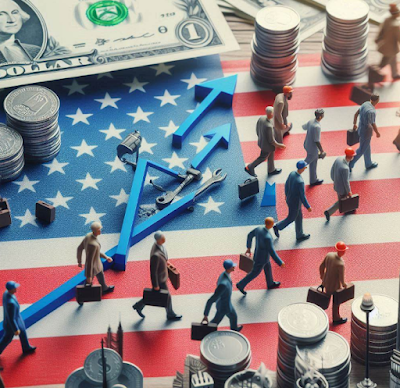Swiss FrancThe Euro has fallen by 0.19% to 1.1503 CHF. |
EUR/CHF and USD/CHF, August 03(see more posts on EUR/CHF, USD/CHF, )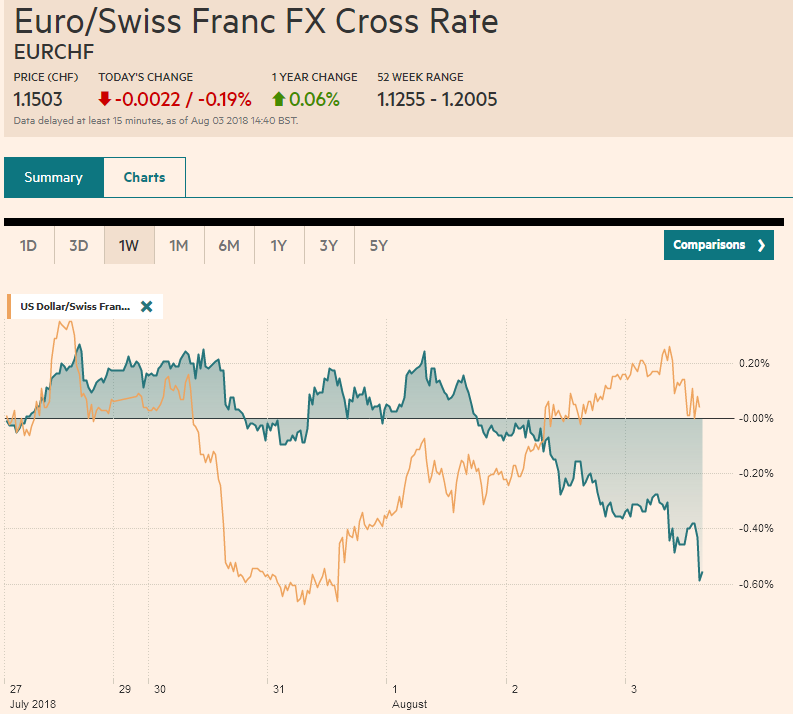 Source: markets.ft.com - Click to enlarge |
FX RatesThe US dollar is trading at the upper end of its recent ranges against the euro and sterling. The euro finished below $1.16 yesterday for the first time since the end of June and has not been able to resurface that level so far today. We recall that it was the last time the euro was pushing below there that US President Trump was spurred a recovery by criticizing Fed policy and then the next day accusing the Europe and China of manipulating their currencies. A 584 mln euro option is struck there and expires today. We note that the euro has risen ahead of the weekend for seven consecutive weeks coming into today. Sterling is straddling the $1.30 level and has thus far held above the July 19 low for the year just below $1.2970. The dollar is steady against the yen and has been confined to about a quarter of a yen range above JPY111.60. There are three sets of options expiring today in this area: $876 mln at JPY111.40, $440 mln at JPY111.75, and $1.7 bln at JPY112.00. The high this week was scored two days ago near JPY112.15. Australia reported slightly better than expected June retail sales (0.4% instead of 0.3%). The central bank meets next week (as does the Reserve Bank of New Zealand) rates are steadfastly on hold (for both). The Australian dollar has been confined to a $0.73-$0.75 range for nearly two months. It dipped below $0.7350 to set a two-week low. There is an option for about A$640 mln struck at $0.7320 that expires today. The Canadian dollar is the strongest of the majors this week, gaining about 0.3% on the US buck helped by stronger economic data (May GDP 0.5% vs expectations for 0.3%). The US dollar has been hovering about CAD1.30 since the GDP data. Important chart support is seen in the CAD1.2950 area. |
FX Performance, August 03 |
United StatesToday’s US employment is a useful exercise in taking the economy’s pulse, but the policy significance is nearly nil. Jobs growth has accelerated this year to a monthly average pace of 215k in H1 from 182k in 2017. Economists mostly expect something around 200k after June’s 213k increase. Maybe there was a slightly lower bias before the ADP data, which was stronger than expected. Even a large downside surprise is unlikely to have lasting impact. It could be shrugged off as an anomaly that other time series have not detected. There is another jobs report that will be released before the FOMC’s late-September meeting. Earnings growth may attract a bit more attention, but remember this is a slow-moving series. Nominal hourly earnings have firmed but have not kept pace with inflation. An above average 0.3% increase is needed to maintain the 2.7% year-over-year pace seen in June. There will be other points of interest, like revisions, where four of this year’s five revisions have been more jobs rather than less. The unemployment rate may tick down, back below 4.0%. The underemployment rate rose to 7.8% from 7.6% as the participation rate rose to 68.9% from 68.7%. Were these trends reversed? Industries that benefitted from import substitution in the wake of the tariffs added manufacturing jobs. Are we going to see the consumer of metals move production offshore, reducing employment? Regardless of the answers (within reason) neither the dollar nor interest rates will be determined or even significantly shaped by today’s report. |
U.S. Unemployment Rate, July 2018(see more posts on U.S. Unemployment Rate, )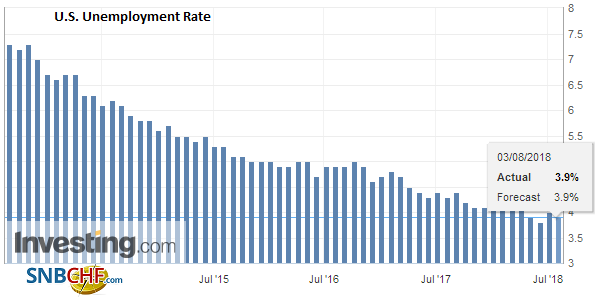 Source: Investing.com - Click to enlarge |
EurozoneThe US dollar remains firm. The eurozone and the UK reported softer than expected service, and composite PMI reports today and BOE’s Carney indicated that although it is a “relatively unlikely possibility,” the risks of a no-deal Brexit are “uncomfortably high,” which also weighed on sterling. The service PMI for EMU slipped to 54.2 from the 54.4 flash report and 55.2 in June. The composite was confirmed at 54.3, which is down from 54.9 in June. The German and French flash composite readings were revised lower. |
Eurozone Services PMI, July 2018(see more posts on Eurozone Services PMI, )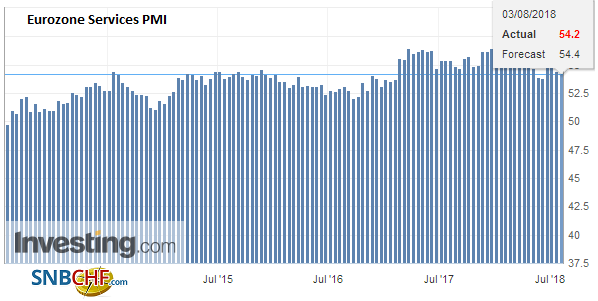 Source: Investing.com - Click to enlarge |
United KingdomThe UK disappointed, as well, a day after the BOE delivered a rate hike that many private sector economists think is a mistake. The services PMI fell to 53.5 from 55.1, and the composite dropped from 55.2 to 53.6, the lowest reading since April. While the JGB market has stabilized (the yield on the 10-year benchmark eased a couple of basis points to finish the week below slightly below 10 bp), it is the Italian debt market that is in the spotlight today. Italian yields are reaching levels not seen since the June meltdown. The 10-year yield is up nine basis points today after rising 12 bp yesterday. The yield was 16 bp higher at the peak today, pushing the benchmark yield above 3%. The two-year yield is up 19 bp at 1.15%. It too jumped more earlier and is pulling back a bit as the European morning progressed. The yield rose about 17 bp yesterday. |
U.K. Services PMI, July 2018(see more posts on U.K. Services PMI, )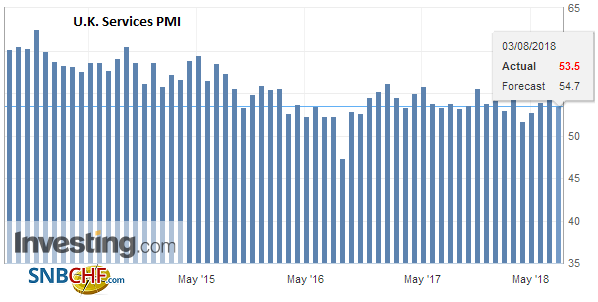 Source: Investing.com - Click to enlarge |
The pressure appears to be spurred by concern that the government is moving to a confrontation with the EC over its budget plans. The League’s Salvini is pushing for tax income tax cuts, while M5S advocates a new assistance program. A meeting is being held today between the two Deputy Prime Ministers and the finance minister.
Outside of Italy, 10-year benchmark yields are mostly a little lower, while equities are mixed. The MSCI Asia Pacific Index fell about 0.25%, bringing the loss for the week to 1.35%, the most since March. China’s Shanghai Composite tumbled 4.6% this week, the most since February. Korea and Taiwan’s equities advanced about 0.75%, allowing the week’s losses to be pared. The Nikkei eked out a minor gain on the day and finished the week 0.8% lower. Good earnings helped lift India’s markets, which are now slightly higher for the week. European bourses are mostly higher, with the Dow Jones Stoxx 600 up about 0.4% to trim the weekly loss to around 1%. The only sector that is not gaining today is energy.
With the US threatening to escalate the trade conflict with China, many observers are trying to link it to the dollar’s strength. Trade wars are not only easy to win, as President Trump has declared, but it is also good for the dollar, we are told. But is it really?
If it is a safe haven, then gold ought to be firmer, but it is sitting at its lowest level in a year. The S&P 500 posted on the bullish outside up day yesterday, closing at a five-day high and poised to challenge the record high. It is true that emerging market equities are under pressure, after trending higher in July. The MSCI Emerging Markets Index has retraced 61.8% of last month’s bounce that peaked on July 26.
This is also ad hocery. It seems that a different narrative is constructed to explain every wiggle in the foreign exchange market, where, in the name of efficiency, the largest pair, the euro-dollar exchange rate is often traded in thousandths of a penny. The difference between JPY111.00 and JPY111.01 is about 100,000th of a cent.
Exactly, why US-inspired trade tensions would be good for the dollar is not exactly explained. Alternatively, consider what has happened over the past week. The ECB affirmed no intention on hiking rates for a year. The BOE hiked rates but said a hike a year is just about the right pace. Japan tweaked its programs not to taper them, which is a way to gradually bring the program to an end, but to extended them indefinitely by trying to minimize the undesirable side effects.
In the US, high-level discussions are underway within the Republican Party for a second round of tax cuts, which would include making the middle-class tax cuts permanent. Other reports indicate that the White House is exploring some relief it can give with executive authority To compensate some farmers for the cost of the retaliatory tariffs, the White House resurrected a New Deal program to offer $12 bln of assistance. The larger than expected deficit has not deterred the government from looking at measures that will expand it further. Investors have good reason to expect that the policy mix, which drove the greenback higher under Reagan and Volcker, and lifted the Deutschmark higher after the Berlin Wall fell, is again in place in a significant way in the US.
Graphs and additional information on Swiss Franc by the snbchf team.
Full story here Are you the author? Previous post See more for Next postTags: #GBP,$AUD,$CAD,$EUR,$JPY,EUR/CHF,Eurozone Services PMI,jobs,newslettersent,Trade,U.K. Services PMI,U.S. Unemployment Rate,USD/CHF































